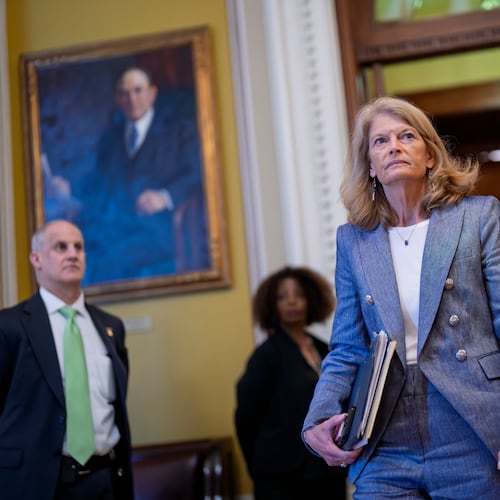At the same time it is scraping for every penny, the state continues to spend more than $3 million a year planting roadside flowers and landscaping, according to the Georgia Department of Transportation.
In fact, The Atlanta Journal-Constitution has learned, the DOT has $1.3 million in flower-planting reserves that it won’t spend on anything else.
Because, according to state officials, that would be illegal.
Even if DOT wanted to bend to the brutal economy and spend the flower-planting money on roads rather than roadsides, it couldn’t. That money comes from the sale of special car license plates with wildflower themes, and state law mandates that the revenues from those tags be spent on beautification, no matter what. It’s in a state statute, and even in the state constitution.
Last year the plate sales brought in $291,000, according to a state audit. Total flower space created: 175 acres a year.
The landscaping money is a different matter. Those funds — about $2.6 million a year reaped from the sale of advertising on highway exit signs, a sum likely to increase soon — were dedicated by a DOT board vote for landscaping at interchanges and highway “gateways” where drivers enter the state, according to the DOT. And the board could decide it wanted to spend the money elsewhere, unlike the wildflower funds, DOT officials said.
“It is very important to have a significant wildflower program and a significant gateway program” for the state’s image and economic development, DOT board member Sam Wellborn told the AJC. “It causes a good impression.”
In the meantime, DOT has cut back highway mowing and trash pickup to save money, leaving roads sometimes looking like county dumps. It has endured a squeeze on road projects, furloughed employees in countless functions, and lost more than 700 workers in a hiring freeze, according to Commissioner Vance Smith. That’s not to mention the harsh cuts being made in the Legislature to the overall state budget.
DOT spokesman David Spear acknowledged that times are “very difficult.” But he said that in terms of DOT’s $2 billion annual budget, “we’re talking about relatively minimal sums of money that we believe bring an exponentially greater aesthetic value to the people who use our system.”
Regarding the wildflower-planting money, Spear said, “the fact remains that all we can do with this money is plant, so we’ll continue to do what we can to maintain what I’ll call these islands of refuge.”
The chairman of the state House’s budget oversight committee, Rep. Richard Smith (R-Columbus), is helping shepherd a bill that would raise a whole roster of state fees, including for the wildflower license plate. It would reroute the way the money flows, but he said the money would still go to beautification. And there’s no move afoot to change that.
“I don’t know of anyone in the state who would vote to repeal that,” Smith told the AJC. If it required amending the state constitution, that would mean a two-thirds vote of the Legislature and a referendum.
The executive director of the Georgia Budget and Policy Institute, Alan Essig, said this is a case study in what’s wrong with constitutional earmarks.
“There’s always different groups that want different taxes dedicated to their causes,” Essig said. While it may sound logical in good times to assure voters that their money will not be poached for some other pet project, “when you’re in tough times it limits your options,” he said.
On the other hand, if people knew that the license plate money wasn’t going to wildflowers, they might not buy them in the first place, said Michael Meyer von Bremen, a former lawmaker who sponsored part of the legislation to create the plates.
There are more than 100 special license plates to choose from, including the bobwhite quail (which generated $419,000 for bobwhite quail preservation last year, according to the audit), the golden retriever ($173,026 to dog and cat sterilization), and breast cancer ($1,008,435 to the indigent care trust fund).
The state used to contribute additional money to the wildflower planting program but has stopped, said Bill Wright, DOT’s landscape architect manager. The program does receive some donations, such as $10,000 from the Garden Club of Georgia last year.
Tally Sweat, a member of the garden club who worked to get the wildflower legislation passed a decade ago, said segregating the wildflower money was a way of making sure it wouldn’t be diverted to other projects. But even in a fiscal crisis like the current one, she said, it still makes sense.
“I would consider this a basic service,” Sweat told the AJC. “I can’t imagine not having some sort of beautification along Georgia roads. The tourist industry is one that the state has promoted, and I think it’s much more pleasant if you’re driving along Georgia’s roadsides [and] you’re tempted to stop.”
The leaders of the garden club, a sweetly formidable force in state politics, haven’t changed their attitude toward the program. “It is one of the projects that we are most proud of,” said Mary Lovings, who heads legislative affairs for the 12,300-member organization.
DOT still likes it, too, considering how popular the program is.
The state has sold more than 164,000 of the license plates since they were introduced in 2000, raising nearly $4 million overall, according to DOT. It costs $45 initially to get a wildflower license plate as opposed to $20 for a regular plate. Renewing it doesn’t cost extra.
The auditors looked for inappropriate use of the funds and didn’t find any.
Part of the success of the program is due to the addition of a new design. For a long time the state sold only wildflower plates showing a black-eyed Susan. But, Wright said in a recent presentation to the DOT board, the new purple coneflower license plate is now outselling the black-eyed Susan plate.
About the Author
Keep Reading
The Latest
Featured



